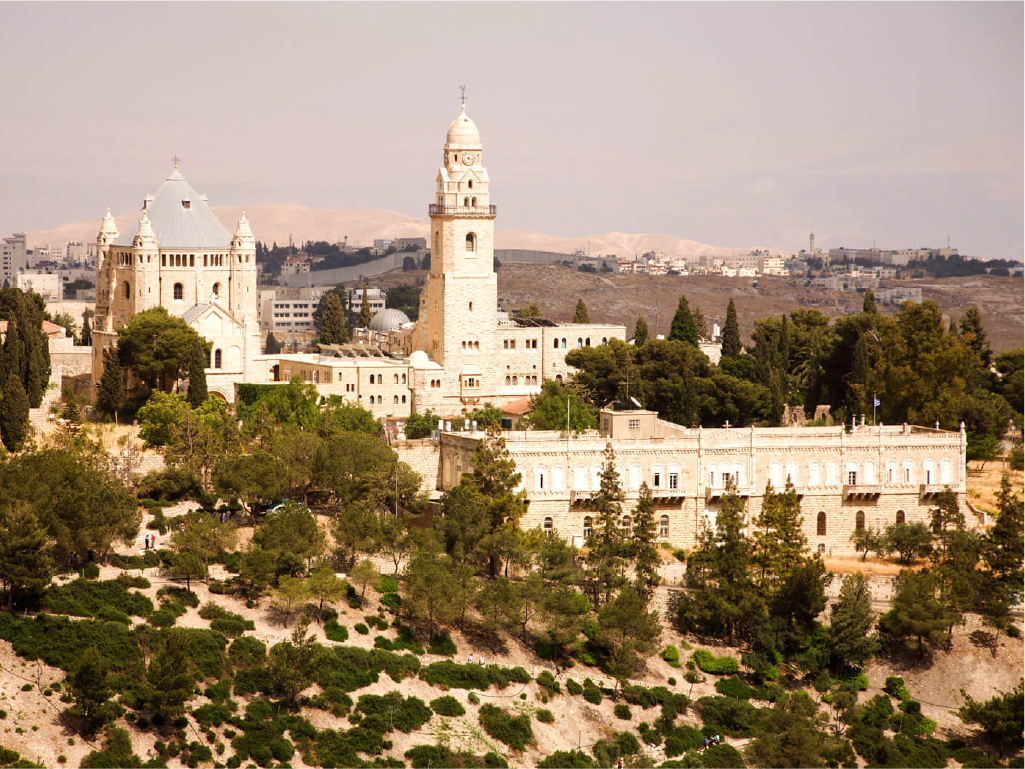
Mount Zion
Located south of the Old City’s Armenian Quarter Mount Zion, was the highest point in ancient Jerusalem. Mount Zion was part of the walled upper city in ancient times, but today is just outside of the Old City walls, close to the Zion Gate.
Several important events in the early Christian Church are likely to have taken place on Mount Zion:
- The Last Supper of Jesus and his disciples, and the coming of the Holy Spirit on the disciples
- The appearance of Jesus before the high priest Caiaphas, believed to have been at the site of the Church of St. Peter in Gallicantu
- The “falling asleep” of the Virgin Mary, believed to have occurred at the site of the Church of the Dormition.
- The Council of Jerusalem, around AD 50, in which the early Church debated the status of converted gentiles (Acts 15:1-29),
Church of Dormition
A massive Benedictine church, with its high, domed bell tower visible from many points in the city, the Church of Dormition commemorates the taking of the Virgin Mary into heaven at the end of her earthly life. The church is next to the place venerated as the tomb of King David, and almost directly above it is the Cenacle – the Upper Room where Jesus celebrated the Last Supper with his disciples. Because of the special sanctity of the site, it became the location of an early Jewish-Christian church known as the Church of the Apostles.
In the early 5th century, Byzantine Christians built the great basilica of Hagia Sion (Holy Zion) on this site. It was destroyed by the Persians in 614. In the 12th century, the crusaders built an even greater church called Santa Maria in Monte Sion (Our Lady of Mount Zion), but it too was destroyed in 1187. The site remained abandoned until the late 19th century, when at the initiative of German Kaiser Wilhelm II the present basilica was built and inaugurated in 1910.
The Dormition is a popular destination for pilgrims and locals alike. Inside, the circular basilica is remarkable for its simplicity and beauty. At the center of its semi-circular apse is a mosaic of Mary and of the child Jesus, with the figures of twelve prophets below them. Around the church are six side chapels decorated by beautiful mosaics depicting scenes such as Mary and the infant Jesus receiving pilgrims, Jesus’ family tree, John the Baptist on the shore of the Jordan River, St. Benedict – the founder of the Benedictine order, and other saints.
Two spiral staircases lead down to the crypt, a round pillared room with a sculpture of Mary “asleep” in the center. On the ceiling above her is the figure of Jesus, as if watching over her, surrounded by the great women of the Bible: Eve, Miriam, Yael, Ruth, Esther and Judith. Beyond this main room, are several other chapels and altars donated by various countries.
With Mary known in Christian tradition as the personified “Daughter of Zion,” closely identified with the people of Israel, it is fitting that her place of rest is preserved on Mount Zion, where Jesus instituted the Eucharist and where the Holy Spirit descended upon the apostles at Pentecost.
David’s Tomb
The traditional site known as King David’s final resting place is often contested, but it is still considered one of the holiest spots in Jerusalem. Located in a medieval-styled building near the Zion Gate, David’s sealed sarcophagus rests in the far back corner of a very busy room (divided for men and women) that is filled with observant Jews praying, singing, or studying. It’s a very moving experience.
Unfortunately, the large sarcophagus is empty, a Gothic cenotaph that the Crusaders put here, and can only serve as a memorial to David (it is still important to preserve his memory). So, who decided that this was the Tomb of David when there’s no body?
The Crusaders, not the Jews, decided upon the site in the 12th century, known today as the Tomb of King David.
During David’s reign (1000 B.C.), Jerusalem’s far western hill (today called Mount Zion and the site of the traditional Tomb of David) was well outside of David’s city walls and probably uninhabited. We know that David, however, was buried “in the City of David,” or inside the city walls to the far east of Mount Zion (2 Samuel 2:10-12). David’s Jerusalem was not the sprawling city we see today. It was a relatively tiny spur on the narrow ridge south of the Temple Mount (today called the City of David), near the Dung Gate. The current Tomb of David, due west of the biblical City of David, was eventually engulfed as Jerusalem grew westward.
As early as 33 A.D., David’s real tomb was well known, as the Apostle Peter testified in Acts 2:29, “Fellow Israelites, I can tell you confidently that the patriarch David died and was buried, and his tomb is here to this day.” So how could the biblical City of David (the eastern hill) get confused with today’s Mount Zion (the western hill) as David’s Jerusalem?
Less than 40 years after Peter’s statement, the Romans destroyed Jerusalem. No Jews were allowed in the city except on the anniversary of the Temple destructions. Ironically, this tragedy occurred on the very same day in 586 B.C. with the Babylonians, and in 70 A.D. with the Romans, the ninth day of the Hebrew month of Av (Tisha B’av). The knowledge of many sites in Jerusalem was lost in the razed wasteland Rome left behind, and it was even more obscured when Hadrian built over the fallen city to make the Roman city of Aelia Capitolina The Jerusalem Peter knew was demolished and rebuilt, with most eyewitnesses dead or gone. More changes would come over the next thousand years, with the Persians and Byzantines fighting over Jerusalem until the Crusaders showed up in 1099 A.D.
By the 12th century, the actual City of David had been buried for centuries, and these Europeans identified the wrong higher western hill as part of that ancient city. They called it Mount Zion. When the Crusaders mistakenly put an empty sarcophagus here, it became an accepted tradition that doesn’t line up with biblical archaeology. King David was buried in the southeastern part of the lower and smaller hill, which is directly south of the Temple Mount, and a half-mile away from the modern Tomb of David.
Upper Room
“On the first day of the Festival of Unleavened Bread, when it was customary to sacrifice the Passover lamb, Jesus’ disciples asked Him, ‘Where do you want us to go and make preparations for you to eat the Passover?’ So, He sent two of His disciples, telling them, ‘Go into the city, and a man carrying a jar of water will meet you. Follow him. Say to the owner of the house he enters, ‘The Teacher asks: Where is my guest room, where I may eat the Passover with my disciples?’ He will show you a large room upstairs, furnished and ready. Make preparations for us there.’ The disciples left, went into the city and found things just as Jesus had told them. So, they prepared the Passover.” (Mark 14:12-14)
The room where tradition says Jesus had the last Passover is in a 12th century Crusader building on the second floor, above the Tomb of David. The site, also called the Cenacle (“dining room”), is near the Zion Gate on Mount Zion. European knights built the site, so logically this cannot be the Upper Room (archaeological evidence confirms this is not King David’s tomb either). An artillery shell fired on the building in 1948 also sitrred up the location debate.
During Israel’s War for Independence, a shell fired on the building led to repairs and digging. An Israeli archeologist, Jacob Pinkerfeld, took the opportunity to investigate the site. He found an indentation in the wall from the original structure he thought might be used for the Torah scrolls typical in synagogues. He said the following about his discovery:
“After removing the plaster from the whole surface of the apse (small Torah niche) there appeared a well-built wall of the late Roman period, constructed of ashlar stones. This is the first building period on the site and to it belong three of the outer walls of the hall on the north, south, and east.”
The ashlar stones were in four mismatched rows in the remains of the partial outer wall. Ashlars are large blocks of stone like we see in the Western Wall, and were frequently re-purposed in other Jerusalem construction after the Romans destroyed the city in 70 A.D. Moving them to new sites usually rounded their corners, which these stones demonstrated. If they had been original, they would have been evenly shaped and set accordingly, but these were not. These stones dated in the late first century to early second century (roughly the same timeframe when Jews were not allowed in Jerusalem), but not early enough for Jesus’ time.
Pinkerfeld continued investigating and dug down about two feet, where he found several previous floors that turned out to be Crusader, Roman (late first century), and even the original floor. He also found some Christian graffiti on the walls in Greek that said, “Conquer, Savior, Mercy,” and another, “Oh Jesus, that I may live. Oh Lord of the Autocrat.” This wasn’t too surprising since the first Christians were all Jews, and these Jewish Christians initially used synagogues to worship Jesus as a normal continuance of Judaism. Our thinking today is that Gentiles are all Christians, but in the first century all the first Christians were Jews, and Gentiles as Christians were the exception (Acts 15). It would be normal for these Jews to use their synagogues for worshipping their risen Messiah.
Combining these clues, it seems this was a synagogue built in the late first century (when Jews were not building new synagogues in Jerusalem), after the Christians returned to Jerusalem from Pella (Jordan) where they went before, Titus destroyed the Temple. Despite all these fascinating discoveries, the site itself remains inconclusive as a first-century dwelling where the Upper Room may have once stood. Only ancient tradition says it is the Last Supper location.
Tradition also says that after Jesus ascended, this Upper Room is where the Church was birthed, as recorded in Acts 1:12-14 and 2:1-3, Then the apostles returned to Jerusalem from the hill called the Mount of Olives, a Sabbath day’s walk from the city. When they arrived, they went upstairs to the room where they were staying.”
“When the day of Pentecost came, they were all together in one place. Suddenly a sound like the blowing of a violent wind came from heaven and filled the whole house where they were sitting. They saw what seemed to be tongues of fire that separated and came to rest on each of them.”
FROM THE SCRIPTURES
A SONG OF ASCENTS. Those who trust in the LORD are like Mount Zion, which cannot be moved, but abides forever. As the mountains surround Jerusalem, so the LORD surrounds his people, from this time forth and forevermore. For the scepter of wickedness shall not rest on the land allotted to the righteous, lest the righteous stretch out their hands to do wrong. Do good, O LORD, to those who are good, and to those who are upright in their hearts! But those who turn aside to their crooked ways the LORD will lead away with evildoers! Peace be upon Israel! (Psalm 125 ESV)
And on the first day of Unleavened Bread, when they sacrificed the Passover lamb, his disciples said to him, “Where will you have us go and prepare for you to eat the Passover?” And he sent two of his disciples and said to them, “Go into the city, and a man carrying a jar of water will meet you. Follow him, and wherever he enters, say to the master of the house, ‘The Teacher says, where is my guest room, where I may eat the Passover with my disciples?’ And he will show you a large upper room furnished and ready; there prepare for us.” And the disciples set out and went to the city and found it just as he had told them, and they prepared the Passover (Mark 14:12-16 ESV).
Then they returned to Jerusalem from the mount called Olivet, which is near Jerusalem, a Sabbath day’s journey away. And when they had entered, they went up to the upper room, where they were staying, Peter and John and James and Andrew, Philip and Thomas, Bartholomew and Matthew, James the son of Alphaeus and Simon the Zealot and Judas the son of James. All these with one accord were devoting themselves to prayer, together with the women and Mary the mother of Jesus, and his brothers. (Acts 1:12-14 ESV).




